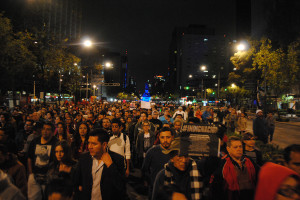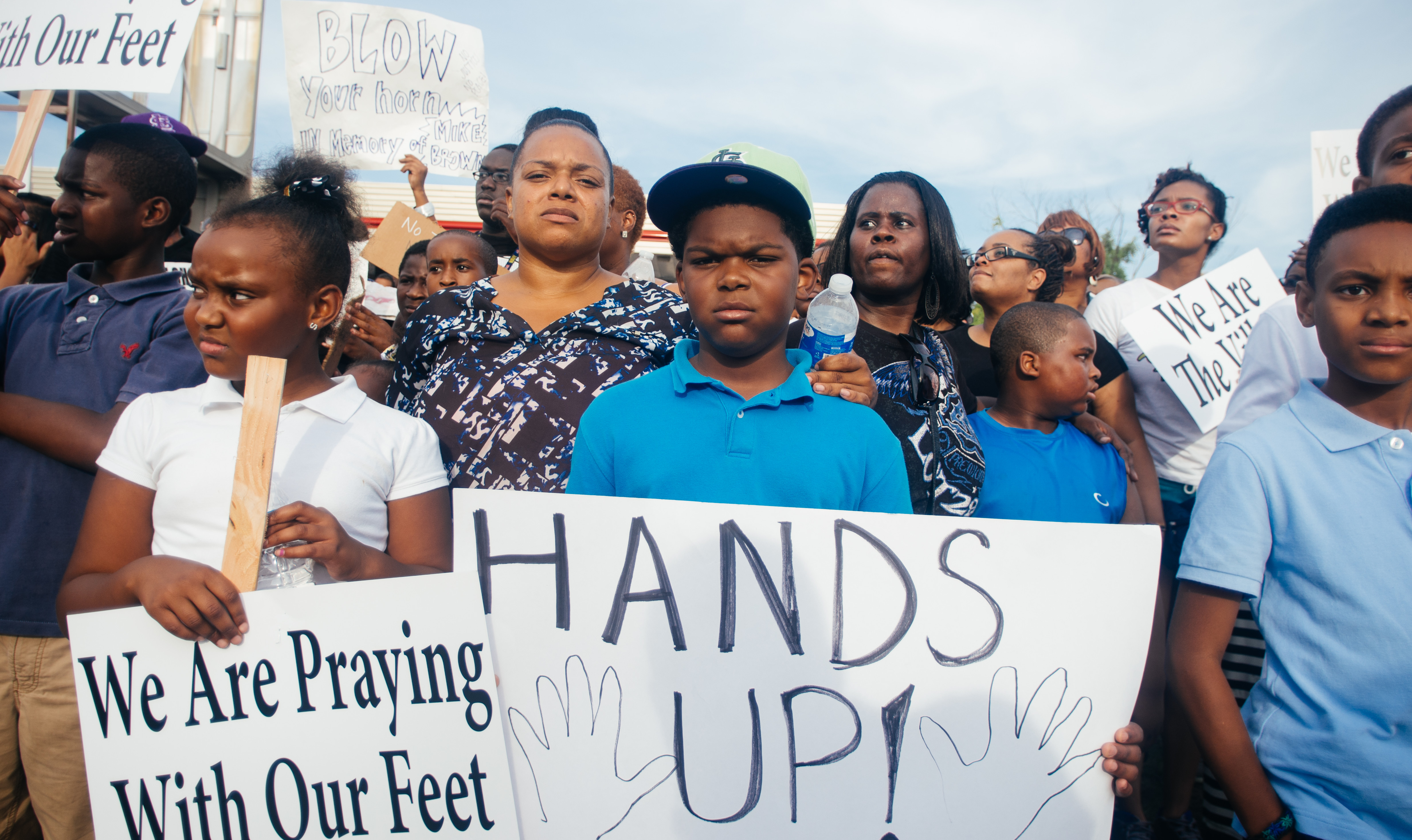Civilians in Mexico and the United States have taken to the streets in recent weeks, protesting injustice and demanding reform On September 26th, 43 students from the rural training college of Ayotzinapa went missing after a confrontation with local policemen. Mexicans have since organized various demonstrations condemning police and state brutality. Meanwhile, in several cities across the United States, thousands are protesting last week’s grand jury decision not to indict police officer Darren Wilson for killing a young African American man, Michael Brown. American indignation increased even further after Officer Daniel Pantaleo, responsible for the death of Eric Garner, was not indicted either. As author and law professor John Ackerman argues, these political junctions offer an unprecedented opportunity for Mexican and American citizens “to unite forces in the fight for peace and equality.”
The parallels in the incidents of Ferguson and Ayotzinapa lend themselves to future coordinated actions against the injustices. Firstly, the victims were innocent civilians from unprivileged backgrounds who were brutalized by state actors. Policemen justified the attacks against Brown and Garner by saying they were perceived as threatening. But this is a systemic problem in a country where racism is embedded in a long historical context. It is within this racialized system that African Americans are more likely to be targeted as criminals, and are most vulnerable to violence. Statistics from the United States Census Bureau reveals that 89 percent of victims from extrajudicial killings by policemen in two of the largest cities in the United States, Chicago and New York, are Black citizens. In Mexico, class and vulnerability to violence are also entwined. Just by virtue of having lived in Guerrero, the poorest and most conflict-ridden state in Mexico, the students from Ayotzinapa were at greater risk of violent persecution.
The notion that race and class determine an individual’s safety should spur outrage in and of itself. The additional factor of police implication in the violence is especially frightening. As the Mexican and US governments failed to bring a sense of justice to the cases, the protests increased tremendously, in strength and in scope. After grand jury’s decisions not to indict Darren Wilson and Daniel Pantaleo, thousands of US citizens in cities across the nation filled up their streets. While 40 local policemen involved in the Ayotzinapa incident have so far been arrested, Jose Luis Abarca, major of Iguala and highly culpable in this tragedy, was only convicted on minor charges. Protesters on both sides of the border expressed fierce indignation towards these incidents and the unfair judicial systems that have failed to account for the guilty actors.
 To the citizens’ discontent, the US and Mexican governments have responded at first with indifference, and at times, with even more violence. On November 9th without having visited the city of Iguala, Peña Nieto flew to China to attend the Asia-Pacific Economic Cooperation summit. On November 27th, two months after event, the President released a statement about Ayotzinapa, but by then his popularity and credibility had heavily dropped. On November 24th, after the grand jury’s decision, Obama called for peace and for measures to combat the systematic problems that have lent to these incidences. But without having proposed concrete actions to start addressing issues, the President’s words felt empty. As protesters repeated when marching together “no justice, no peace:” peace may come only when justice is delivered.
To the citizens’ discontent, the US and Mexican governments have responded at first with indifference, and at times, with even more violence. On November 9th without having visited the city of Iguala, Peña Nieto flew to China to attend the Asia-Pacific Economic Cooperation summit. On November 27th, two months after event, the President released a statement about Ayotzinapa, but by then his popularity and credibility had heavily dropped. On November 24th, after the grand jury’s decision, Obama called for peace and for measures to combat the systematic problems that have lent to these incidences. But without having proposed concrete actions to start addressing issues, the President’s words felt empty. As protesters repeated when marching together “no justice, no peace:” peace may come only when justice is delivered.
Now that protests have been replicated in multiple cities in the United States and Mexico, new instances of police repression have become another factor that could potentially unify the two movements. In Mexico City alone, 11 students were arrested during a demonstration on November 20th: The students were taken by the police without an arrest warrant, tortured, sent to a high-security prison outside the capital and later accused of terrorism. On November 28th, another student was kidnapped by policemen dressed as civilians outside the National University campus. Because this incident was recorded and rapidly diffused in the media, he was quickly liberated along with the other students, against whom no evidence of crime was found. In Ferguson, policemen were utilized tear gas against protestors. In a more recent event, students from University California Berkeley uploaded a video where policemen used rubber bullets to break their recent demonstration.
On December 2nd, a transnational video call connected Ayotzinapa and Ferguson. Ernestina Lugardo, Yolanda González and Metodia Carrillo, mothers of three of the missing students in Guerrero, shared some words with Mama Kat Daniels, a mother and female activist in Missouri. The conversation was live-streamed and projected to a larger audience in various US universities, including Brown. Both sides expressed their solidarity while holding back tears. Their shared pain incited the public to ask what actions could be done to support these movements for change. Omar García, a surviving student from Ayotzinapa who was also present in the online dialogue, emphasized the importance of international pressure for having their demands heard by the Mexican politicians. This event opened up a new chance for future collaboration. Mexicans and US citizens must start taking advantage of their simultaneous uprisings to work alongside each other. By uniting their fights, movements in the United States and Mexico may more effectively instigate the much-needed changes in the judicial systems for both countries.
It is oftentimes overlooked that the proximity of the United States and Mexico can supportive positive societal outcomes. Many of the governmental policies affecting Mexican citizens are also affecting citizens in the United States. These governments work collaborative, and their actions and policies should be mutually conscious. It is no coincidence that both Mexican and US political classes marginalize and systematically oppressed the most unprivileged members of their societies. The deaths of Mike Brown, Eric Garner and the 43 normalistas occurred within this political context and should therefore not be treated as isolated cases. They were not the first, and will not be the last until there is more impactful policy change. Perhaps this cross-border solidarity is the necessary tipping point.
